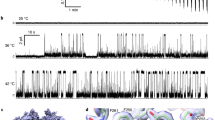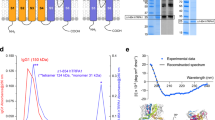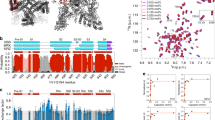Abstract
TRPV1 is the founding and best-studied member of the family of temperature-activated transient receptor potential ion channels (thermoTRPs). Voltage, chemicals and heat allosterically gate TRPV1. Molecular determinants of TRPV1 activation by capsaicin, allicin, acid, ammonia and voltage have been identified. However, the structures and mechanisms mediating TRPV1's pronounced temperature sensitivity remain unclear. Recent studies of the related channel TRPV3 identified residues in the pore region that are required for heat activation. We used both random and targeted mutagenesis screens of rat TRPV1 and identified point mutations in the outer pore region that specifically impair temperature activation. Single-channel analysis indicated that TRPV1 mutations disrupted heat sensitivity by ablating long channel openings, which are part of the temperature-gating pathway. We propose that sequential occupancy of short and long open states on activation provides a mechanism for enhancing temperature sensitivity. Our results suggest that the outer pore is important for the heat sensitivity of thermoTRPs.
This is a preview of subscription content, access via your institution
Access options
Subscribe to this journal
Receive 12 print issues and online access
$209.00 per year
only $17.42 per issue
Buy this article
- Purchase on Springer Link
- Instant access to full article PDF
Prices may be subject to local taxes which are calculated during checkout




Similar content being viewed by others
Accession codes
References
Caterina, M.J. Transient receptor potential ion channels as participants in thermosensation and thermoregulation. Am. J. Physiol. Regul. Integr. Comp. Physiol. 292, R64–R76 (2007).
Dhaka, A., Viswanath, V. & Patapoutian, A. Trp ion channels and temperature sensation. Annu. Rev. Neurosci. 29, 135–161 (2006).
Dhaka, A. et al. TRPV1 is activated by both acidic and basic pH. J. Neurosci. 29, 153–158 (2009).
Brauchi, S., Orio, P. & Latorre, R. Clues to understanding cold sensation: thermodynamics and electrophysiological analysis of the cold receptor TRPM8. Proc. Natl. Acad. Sci. USA 101, 15494–15499 (2004).
Caterina, M.J. et al. The capsaicin receptor: a heat-activated ion channel in the pain pathway. Nature 389, 816–824 (1997).
Tominaga, M. et al. The cloned capsaicin receptor integrates multiple pain-producing stimuli. Neuron 21, 531–543 (1998).
Voets, T. et al. The principle of temperature-dependent gating in cold- and heat-sensitive TRP channels. Nature 430, 748–754 (2004).
Caterina, M.J. et al. Impaired nociception and pain sensation in mice lacking the capsaicin receptor. Science 288, 306–313 (2000).
Davis, J.B. et al. Vanilloid receptor-1 is essential for inflammatory thermal hyperalgesia. Nature 405, 183–187 (2000).
Güler, A.D. et al. Heat-evoked activation of the ion channel, TRPV4. J. Neurosci. 22, 6408–6414 (2002).
McKemy, D.D., Neuhausser, W.M. & Julius, D. Identification of a cold receptor reveals a general role for TRP channels in thermosensation. Nature 416, 52–58 (2002).
Peier, A.M. et al. A TRP channel that senses cold stimuli and menthol. Cell 108, 705–715 (2002).
Peier, A.M. et al. A heat-sensitive TRP channel expressed in keratinocytes. Science 296, 2046–2049 (2002).
Smith, G.D. et al. TRPV3 is a temperature-sensitive vanilloid receptor–like protein. Nature 418, 186–190 (2002).
Story, G.M. et al. ANKTM1, a TRP-like channel expressed in nociceptive neurons, is activated by cold temperatures. Cell 112, 819–829 (2003).
Xu, H. et al. TRPV3 is a calcium-permeable temperature-sensitive cation channel. Nature 418, 181–186 (2002).
Talavera, K. et al. Heat activation of TRPM5 underlies thermal sensitivity of sweet taste. Nature 438, 1022–1025 (2005).
Togashi, K. et al. TRPM2 activation by cyclic ADP-ribose at body temperature is involved in insulin secretion. EMBO J. 25, 1804–1815 (2006).
Gavva, N.R. et al. Molecular determinants of vanilloid sensitivity in TRPV1. J. Biol. Chem. 279, 20283–20295 (2004).
Jordt, S.E. & Julius, D. Molecular basis for species-specific sensitivity to 'hot' chili peppers. Cell 108, 421–430 (2002).
Jordt, S.E., Tominaga, M. & Julius, D. Acid potentiation of the capsaicin receptor determined by a key extracellular site. Proc. Natl. Acad. Sci. USA 97, 8134–8139 (2000).
Ryu, S., Liu, B., Yao, J., Fu, Q. & Qin, F. Uncoupling proton activation of vanilloid receptor TRPV1. J. Neurosci. 27, 12797–12807 (2007).
Ahern, G.P., Brooks, I.M., Miyares, R.L. & Wang, X.B. Extracellular cations sensitize and gate capsaicin receptor TRPV1 modulating pain signaling. J. Neurosci. 25, 5109–5116 (2005).
Salazar, H. et al. A single N-terminal cysteine in TRPV1 determines activation by pungent compounds from onion and garlic. Nat. Neurosci. 11, 255–261 (2008).
Nilius, B. et al. Gating of TRP channels: a voltage connection? J. Physiol. (Lond.) 567, 35–44 (2005).
Voets, T., Owsianik, G., Janssens, A., Talavera, K. & Nilius, B. TRPM8 voltage sensor mutants reveal a mechanism for integrating thermal and chemical stimuli. Nat. Chem. Biol. 3, 174–182 (2007).
Latorre, R., Brauchi, S., Orta, G., Zaelzer, C. & Vargas, G. ThermoTRP channels as modular proteins with allosteric gating. Cell Calcium 42, 427–438 (2007).
Matta, J.A. & Ahern, G.P. Voltage is a partial activator of thermo-sensitive TRP channels. J. Physiol. 585, 469–482 (2007).
Brauchi, S., Orta, G., Salazar, M., Rosenmann, E. & Latorre, R. A hot-sensing cold receptor: C-terminal domain determines thermosensation in transient receptor potential channels. J. Neurosci. 26, 4835–4840 (2006).
Grandl, J. et al. Pore region of TRPV3 ion channel is specifically required for heat activation. Nat. Neurosci. 11, 1007–1013 (2008).
Long, S.B., Campbell, E.B. & Mackinnon, R. Crystal structure of a mammalian voltage-dependent Shaker family K+ channel. Science 309, 897–903 (2005).
Liu, B., Hui, K. & Qin, F. Thermodynamics of heat activation of single capsaicin ion channels VR1. Biophys. J. 85, 2988–3006 (2003).
Hille, B. Ion Channels of Excitable Membranes (Sinauer Associates, Sunderland, Massachusetts, 2001).
Premkumar, L.S., Agarwal, S. & Steffen, D. Single-channel properties of native and cloned rat vanilloid receptors. J. Physiol. (Lond.) 545, 107–117 (2002).
Hui, K., Liu, B. & Qin, F. Capsaicin activation of the pain receptor VR1: multiple open states from both partial and full binding. Biophys. J. 84, 2957–2968 (2003).
Talavera, K., Nilius, B. & Voets, T. Neuronal TRP channels: thermometers, pathfinders and life-savers. Trends Neurosci. 31, 287–295 (2008).
Kern, D. & Zuiderweg, E.R. The role of dynamics in allosteric regulation. Curr. Opin. Struct. Biol. 13, 748–757 (2003).
Yang, F., Cui, Y., Wang, K. & Zheng, J. Thermosensitive TRP channel pore turret is part of the temperature activation pathway. Proc. Natl. Acad. Sci. USA 107, 7083–7088 (2010).
Brauchi, S. et al. Dissection of the components for PIP2 activation and thermosensation in TRP channels. Proc. Natl. Acad. Sci. USA 104, 10246–10251 (2007).
Myers, B.R., Bohlen, C.J. & Julius, D. A yeast genetic screen reveals a critical role for the pore helix domain in TRP channel gating. Neuron 58, 362–373 (2008).
Bandell, M. et al. High-throughput random mutagenesis screen reveals TRPM8 residues specifically required for activation by menthol. Nat. Neurosci. 9, 493–500 (2006).
Qin, F., Auerbach, A. & Sachs, F. Estimating single-channel kinetic parameters from idealized patch-clamp data containing missed events. Biophys. J. 70, 264–280 (1996).
Qin, F., Auerbach, A. & Sachs, F. Maximum likelihood estimation of aggregated Markov processes. Proc. Biol. Sci. 264, 375–383 (1997).
Acknowledgements
We thank A. Marelli and T. Orth for preparing mini-prep DNA, M. Caterina for providing rat TRPV1 plasmid DNA, and B. Coste for critical reading of the manuscript. This research was supported by the US National Institutes of Health, the Novartis Research Foundation and a fellowship to J.G. from the American Heart Association.
Author information
Authors and Affiliations
Contributions
J.G. designed the study, collected and analyzed data, and wrote the manuscript. S.E.K. collected and analyzed data in the primary screen. V.U. prepared the mutant library and collected and analyzed data in the primary screen. B.B. performed molecular modeling. M.P. prepared the mutant library. M.B. developed the screening conditions. A.P. designed the study and edited the manuscript. All of the authors discussed the results and commented on the manuscript.
Corresponding author
Ethics declarations
Competing interests
The authors declare no competing financial interests.
Supplementary information
Supplementary Text and Figures
Supplementary Figures 1–5 (PDF 743 kb)
Rights and permissions
About this article
Cite this article
Grandl, J., Kim, S., Uzzell, V. et al. Temperature-induced opening of TRPV1 ion channel is stabilized by the pore domain. Nat Neurosci 13, 708–714 (2010). https://doi.org/10.1038/nn.2552
Received:
Accepted:
Published:
Issue Date:
DOI: https://doi.org/10.1038/nn.2552
This article is cited by
-
Relation between flexibility and intrinsically disorder regions in thermosensitive TRP channels reveal allosteric effects
European Biophysics Journal (2024)
-
Two single-point mutations in Ankyrin Repeat one drastically change the threshold temperature of TRPV1
Nature Communications (2023)
-
Fetal cannabidiol (CBD) exposure alters thermal pain sensitivity, problem-solving, and prefrontal cortex excitability
Molecular Psychiatry (2023)
-
Magnetothermal-based non-invasive focused magnetic stimulation for functional recovery in chronic stroke treatment
Scientific Reports (2023)
-
Bursting types and bifurcation analysis of the temperature-sensitive Purkinje neuron
Nonlinear Dynamics (2023)



